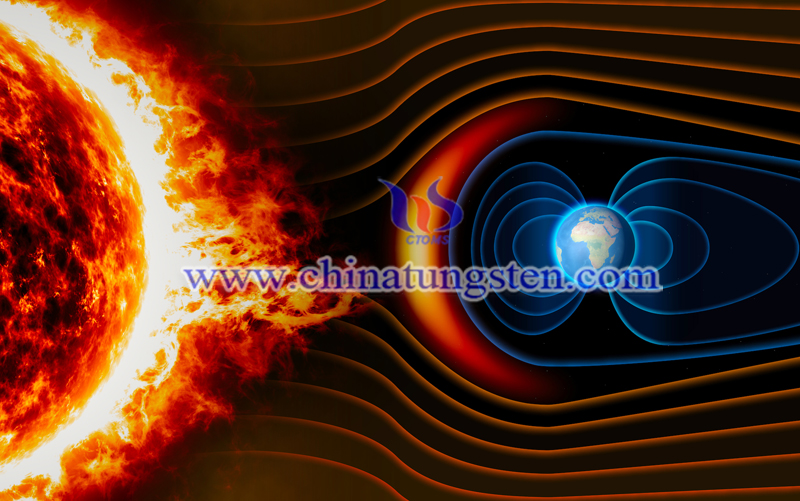Measure Lithium in Zircon Crystals, Earth Magnetic Field or Earlier Than Expected
- Details
- Category: Tungsten's News
- Published on Monday, 10 February 2020 21:09
Researchers have found evidence from areas rich in lithium in zircon crystals, which indicate that the Earth magnetic field or earlier than expected. According to Science, researchers have found more evidence that our planet had a strong magnetic field 4.2 billion years ago or 350 million years after Earth formed, which was 750 million years earlier than previously thought. The magnetic field will put a protective cover on the earth to protect the atmosphere from the sun's high-energy particles, and helping life to gain a foothold.
With scarcely remaining rocks available for research, geologists struggled to reconstruct the Earth's ancient period-from 4.55 billion to 4 billion years ago. But from the young rocks of Mount Jack in Western Australia 3 billion years ago, scientists can find fragmented but controversial clues. The rocks contain tiny crystals of a hard mineral called zircon, which fell off of older blocks, the ancient formation of the ancient zeazhou rock formed 4.2 billion years ago by cooling magma.
An international research team led by geophysicist John Tarduno of the University of Rochester, New York, USA, said that the crystals also preserved evidence of the ancient Earth's magnetic field. But not all researchers believe the results, as it pushed the recognized Earth's magnetic field "birthday" forward by 750 million years. "There are a lot of research groups trying to prove our findings wrong," Tarduno said.
In 2015, Tarduno and colleagues reported the discovery for the first time in Science. There are about 24 zircons in the rocks, tiny particles of magnetite, an iron-containing mineral that effectively turns each crystal into a miniature strip magnet. Researchers have found that the magnetic fields contained in these particles are consistent, and this happens only when the magnetite is cooled and exposed to the Earth magnetic field.
Tarduno's team says that magnetization was an imprint of 4.2 billion years ago when the original zircon cooled for the first time. At any given moment, however, if the magnetite particles become hot enough-above about 600 degrees Celsius, they will lose their magneto arrangement and regain a new magnetic alignment when they cool down again.
MIT geologist Benjamin Weiss questioned Tarduno's claims that "a heating event like this may have occurred 2.6 billion years ago." He said, "These zircons have an incredibly long and unknown history."

In the recent issue of the Proceedings of the National Academy of Sciences, the Tarduno research team collected a set of new evidence that magnetization occurred in ancient times rather than long after. There are areas rich in lithium-ion in zircon crystals that, when heated, seep into adjacent areas over time through a process known as chemical diffusion. Tarduno and colleagues measured the concentration of lithium at these regional boundaries in three zircon crystals. In both crystals, they found limited evidence of diffusion. This suggests that they have never been heated above 600 degrees Celsius in their 4.2 billion-year history - their magnetic properties are primitive, Tarduno said. "I think it's a remarkable discovery."
What's more, on the other hand, zircon crystals that show signs of heating are an exception: it retains abnormally weak magnetic signals. In 2015, Tarduno and colleagues concluded that this could be evidence of a strangely changing magnetic field 4.2 billion years ago. But now he thinks that this particular zircon seems to have acquired magnetism later, and when discussing the earliest magnetic field of the earth, the weak signal it retains can be ignored. Tarduno says this suggests that in the ancient times, the earth had a magnetic field, with a geomagnetic generator at its core that was as powerful as it is today.
Geologist Mark Harrison of the University of California, Los Angeles is not convinced by the new study. Because lithium ions penetrate the boundary, it takes high temperatures and a long time. If the heating causes the zircon to exceed 600 degrees Celsius, it will be enough to reset the magnetism of the zircon and non-proliferation of lithium-ion, even though it has only been preserved for 10,000 years. "I don't think it's conclusive evidence". He said.
Claire Nichols, a geologist at MIT who was not involved in any Jack Mountain research, said that by analyzing the rocks of Greenland, the Earth magnetic field existed at least 3.7 billion years ago. "It's good that different research teams are pushing each other to use more and more advanced technology. "This gives us the best chance to understand the earliest records of geomagnetic generators," she said.
- Tungsten Manufacturer & Supplier, Chinatungsten Online: www.chinatungsten.com
- Tungsten News & Prices of China Tungsten Industry Association: www.ctia.com.cn
- Molybdenum News & Price: news.molybdenum.com.cn
- Tel.: 86 592 5129696; Fax: 86 592 5129797; Email: sales@chinatungsten.com



 sales@chinatungsten.com
sales@chinatungsten.com